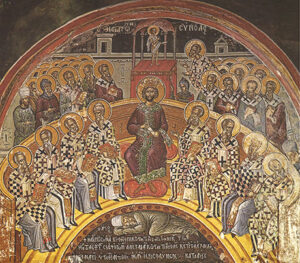Seventeen hundred years ago, more than 300 bishops and officials participated in the first ecumenical council of the Christian church. It met between May and August 325, in the Byzantine city of Nicea (now İznik, northwestern Turkey), hence its traditional name—the First Council of Nicea.
The council was convoked by Emperor Constantine I (r. 306–337) to address the Arian controversy that threatened the unity of the early church. For Constantine, the church was a unifying force within his vast empire, and doctrinal disputes threatened to undermine that unity as well as his secular authority. The council rejected Arius’s teaching about the subordination of the Son to the Father and adopted the first universal dogmatic definition of the church, the Nicene Creed, which recognized the full divinity of Christ and his equality with the Father, declaring the Son “consubstantial (of one substance) with the Father.”
The council also ordered that Easter be celebrated on the Sunday after the full moon following the spring equinox, which meant that Easter would not coincide with the Jewish Passover celebrated on the actual day the paschal lamb was slaughtered (Nisan 14).
Church councils are formal deliberative bodies of church representatives that discuss and regulate disputed questions of church doctrine and discipline. Ecumenical (i.e., universal) councils of antiquity represented the entire Roman/Byzantine Empire. Seven such councils met before the Great Schism between the Roman Catholic and Eastern Orthodox churches in the 11th century.


